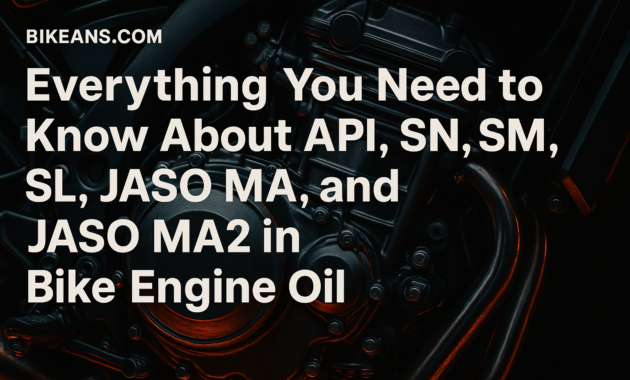
Everything You Need to Know About API, SN, SM, SL, JASO MA, and JASO MA2 in Bike Engine Oil:
When choosing the best engine oil for your motorcycle, you’ll come across a range of mysterious codes like API SN, SM, SL, and JASO MA or MA2. But what do these acronyms mean? Are they important, or just marketing jargon? The truth is—they’re very important. These specifications tell you whether a particular engine oil is suitable for your bike’s performance, durability, and clutch protection.
Let’s break down each of them, starting with the API.
🛢️ What is API in bike engine oil?
API stands for the American Petroleum Institute. It’s a major organization in the oil and gas industry that sets standards and quality grades for lubricants used in engines, including those in motorcycles.
The API rating ensures that the engine oil meets specific performance and safety benchmarks. These benchmarks are based on real-world engine testing, wear protection, high-temperature stability, and deposit control.
When you see API SN, SM, or SL on a bottle of engine oil, these are performance categories defined by the API. Here’s what they mean:
🔍 API SN, SM, and SL – Explained
These letters indicate the oil’s quality and its suitability for certain engine types. The higher the letter (in alphabetical order), the more advanced the oil’s formulation is.
✅ API SN (Introduced in 2010)
- The most recent of the three.
- Offers superior high-temperature deposit protection.
- Better control over sludge formation.
- Designed to support modern engines with emissions systems and turbochargers.
- Ideal for most modern motorcycles.
✅ API SM (Introduced in 2004)
- Offers improved oxidation resistance.
- Reduces engine wear and minimizes deposits.
- Compatible with oils designed for high-mileage bikes.
✅ API SL (Introduced in 2001)
- A step below SM and SN.
- Still suitable for many bikes, especially older models.
- Provides decent wear protection and cleanliness but lacks the advanced features of newer standards.
In summary:
- SN = Best for new bikes.
- SM = Good for mid-2000s models.
- SL = Better for older motorcycles.
🏍️ What is JASO in bike engine oil?
JASO stands for the Japanese Automotive Standards Organization. While the API categories are great, they’re more focused on cars. Motorcycles have different needs—especially regarding the wet clutch system. That’s where JASO ratings come in.
JASO ensures that engine oil is not just good for the engine but also suitable for the clutch and gearbox in motorcycles. Unlike cars, most bikes use a shared oil system for the engine, gearbox, and clutch. That’s why JASO is a crucial label to look for in motorcycle oil.
🏁 JASO MA vs. JASO MA2—What’s the Difference?
Both JASO MA and MA2 are designed for motorcycles with wet clutches, but there are differences in performance, especially regarding clutch friction.
🛡️ JASO MA
- Suitable for most motorcycles with wet clutches.
- Provides good clutch performance under standard operating conditions.
- Prevents clutch slippage and maintains torque delivery.
🚀 JASO MA2
- A refined version of MA, introduced for higher-performance bikes.
- Offers enhanced friction performance.
- Ensures better grip and reduced slippage even under high-stress or racing conditions.
- Recommended for bikes with advanced transmission systems or used in tough riding environments
👉 If you’re riding a modern or performance-oriented bike, go for JASO MA2.
👉 If you’re riding a standard or commuter motorcycle, JASO MA is sufficient.
✅ Why These Specifications Matter
Choosing the right engine oil isn’t just about brand loyalty or viscosity grade, like 10W-40 or 10W-30. It’s also about compatibility with your engine and riding style. Here’s why these specs are crucial:
- API ratings (SN, SM, SL) indicate how well the oil will protect your engine.
- JASO ratings (MA, MA2) ensure the oil won’t mess with your clutch or gear shifting.
- They help you pick an oil that matches the technology level of your bike.
- Avoiding the wrong rating prevents engine damage, clutch slippage, and excessive wear.
⚙️ What Does SAE Mean in Bike Engine Oil?
SAE stands for the Society of Automotive Engineers. It’s a professional organization that sets the viscosity grading system for engine oils, which is why you’ll see codes like SAE 10W-40, SAE 20W-50, etc., on oil containers.
These numbers are all about how thick or thin the oil is at different temperatures:
🔧 How to Read SAE Grades
Take SAE 10W-40 as an example:
“10W” stands for oil’s cold weather viscosity. The lower the number you see before the “W” (Winter), the better the oil for cold starts.
“40” meaning oil’s viscosity at high temperatures. A higher number means thicker oil when the engine is hot, which can protect better under stress.
🏍️ Why It Matters for Bikes
Motorcycles operate at higher RPMs and often in tougher conditions than cars. So using the correct SAE viscosity ensures:
- Easier engine starts on cold mornings.
- Proper lubrication when the engine heats up.
- Stable performance across different weather and riding styles.
👉 Always check your owner’s manual for the recommended SAE grade.
🔚 Final Thoughts
In the world of motorcycles, engine oil isn’t just a maintenance product—it’s the lifeblood of your engine. Whether you’re riding a commuter bike or a high-performance machine, understanding these codes helps you make smarter, safer, and more efficient choices.
Next time you’re buying engine oil, don’t just look at the brand. Look for:
- API SN, SM, or SL based on your bike’s age and tech level.
- JASO MA2 for performance or JASO MA for daily use.
Because when it comes to performance and protection, details matter.
NOTE:
While we strive for accuracy, the information presented above may contain occasional errors. Our content is sourced from reputable channels, including official manufacturer websites. Should you notice any inaccuracies or outdated details, we welcome your feedback to help us maintain the highest quality information.”

